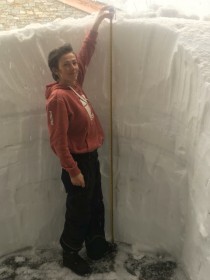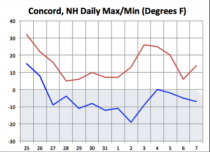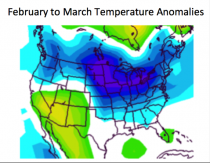By Francis Menton, Manhattan Contrarian
Regular readers here will know that one of the things I do in my semi-retirement is represent a group of scientists who are appalled by what masquerades under the name of “science” in popular discourse about climate change. Our effort in various venues is to educate as to the ways in which the so-called “scientific consensus” of impending catastrophic global warming is not scientific at all, and is the opposite of science.
It’s not just that “consensus” is irrelevant to real science, and can frequently be overturned. It’s that there’s an entire suite of criteria by which the promotion of climate hysteria departs from science and the scientific method: For example, where is the falsifiable hypothesis? What is the null hypothesis? What are that data that, if they emerged, would be conceded to falsify the falsifiable hypothesis? In lieu of a hypothesis that can be falsified, we find frequent assertions that literally everything—including facts that are the direct opposite of each other—constitutes proof that global warming “is occurring” and will inevitably have catastrophic effects. One day there is a claim that snow will be a thing of the past (it’s getting warmer!) and the next day a big snow storm is claimed as evidence of the damaging effects of global warming (we told you to expect more extreme weather!). One day a drought is claimed as evidence of catastrophic effects of global warming, and the next day it’s a flood being claimed as evidence of the same. Meanwhile, has there been any actual verification of a falsifiable hypothesis—and is it a verification that can be replicated by others? And, why are critical data being cherry-picked and/or altered to support the “consensus”?
We all learned the fundamentals of the scientific method back in high school, or even junior high school. Isn’t it obvious to everyone that the antics of climate change alarm promoters are unscientific and anti-scientific?
Unfortunately, as I frequently point out to my colleagues, on important political issues, very few human minds can be changed by mere reason and logic, no matter how ironclad that reason and logic may be. We may think we are creatures of reason, but that’s only a veneer. The famous quote is attributed to Jonathan Swift:
“Reasoning will never make a Man correct an ill Opinion, which by Reasoning he never acquired.”
On the other hand, there are things that can persuade even those who are very difficult to persuade. Consider, for example, how your views of intermittent “renewable” energy sources as a remedy for climate change might be affected by a tripling—or maybe a quintupling—of your electricity bill. Then throw in a few power blackouts for good measure. And finally, let the information seep through that emissions aren’t even going down! Which brings us back to the case of Germany.
As I noted in this post back in November, as recently as 2015 there was no political party of any significance anywhere in Europe that stood against climate change hysteria and against the huge increases in wind and solar power generation claimed necessary to save us from climate disaster. Work by Norwegian political scientist Sondre Batstrand, summarized here in the Guardian in October 2015, had concluded that “the US Republican Party stands alone in its rejection of the need to tackle climate change and efforts to become the party of climate supervillains.” In Germany, as recently as last year, no political party representing a dissenting position on any aspect of the climate “consensus” held a single seat in the Bundestag. But Germany’s Energiewende ("energy transition"), instituted in 2010, had caused Germany’s consumer electricity prices to skyrocket since the prior national elections in 2013.
Then, in the September 2017 elections, two parties thought to represent climate skepticism at least to some degree—the FDP (Free Democrats) and AfD (Alliance for Germany)—suddenly won some 24.6% of the seats in the Bundestag. OK, but exactly how serious are these people in their climate skepticism? We learn about that from an excellent post today at the site NoTricksZone, titled “Green energy opposition becoming formidable force in Germany.”
It appears that over the past couple of weeks, two young members of the Bundestag, one from the FDP and the other from AfD, made their first speeches in the parliament, and chose the subject of climate. Videos of their speeches are included at the link, but I won’t embed them here, because they are in German and I assume that few readers could understand them. However, Pierre Gosselin of NTZ clearly understands the language, and provides translations and paraphrases of some extended excerpts.
From Sandra Weeser of FDP:
In her speech Weeser points out that despite the rapidly growing green energy capacity being installed, the effort to reduce CO2 has failed, and what’s left is an unpredictable power grid that often produces energy when it is not needed (waste energy) and thus costing Germans hundreds of millions annually. She also accuses the established politicians of ignoring citizens as they ruin Germany’s landscape with wind parks.
“Interestingly it is often Green party voters who we find themselves among wind park protesters. In their daily lives these people are recognizing that what is being sold as green electricity in fact has nothing to do with being green. They are rejecting the industrial turbines in forests."…
Weeser also dismisses claims by the Green Party that wind energy is “the most inexpensive” on the market, asking them directly: “If that is really true, then why do they need subsidies? Why are we paying 25 billion euros annually for their feed-in?”
From Dr. Rainer Kraft of AfD:
Kraft slams the government’s climate-protection approach of spending “15 euros to avoid 1 euro of damage” as a policy one would expect from “a fool.” Adding: “there just couldn’t be less scientific understanding than that.” Echoing Donald Trump’s ideas on international treaties, Kraft also sees them as being ruinous to German industry, and that the ultimate target of climate protection is to establish “an eco-socialist centrally-planned economy” and that climate protection is the “instrument” to bring it about. He then labeled the Greens’ energy policy as “eco-populist voodoo.”
Gosselin concludes:
[E]xpect the traditional established parties to continue seeing the unheard of erosion among their disenchanted voter bases. Never has postwar Germany seen a political shift on such a massive scale… Though 25% may not sound impressive, it is amazing when one considers that only a decade ago there was virtually universal parliamentary support for green energies. Those days are over. And now as the failure of the Energiewende becomes ever more glaring, reaching the political tipping point on the issue of the Energiewende is just a question of a few more years.
By the way, according to this post on Clean Energy Wire on January 5, Germany got the percent of its electricity from “renewables” all the way up to 36.1% in 2017, from about 32.3% in 2016. Oh, but its total CO2 emissions actually increased.
[T]he country’s total emissions stagnated for the third year in a row, because more oil and gas were used in transport, heating and industry…
Unfortunately, changing minds in Germany has required the people to act as guinea pigs for a decade or so in the grand experiment in “eco-populist voodoo.” The same method will work equally well in the U.S. Sadly, I appear to live in one of the places whose residents are among the designated guinea pigs.
By Joseph D’Aleo
During the latter stages of co-authoring a book honoring the Weather Channel Pioneers (coming soon), John Coleman sadly passed away January 20th at age 83 at his home in Las Vegas surrounded by friends and family. John Coleman retired in 2014 after nearly 61 years in weather broadcasting.
John learned to love weather and nature from his dad, a college professor who had been raised on a farm in Alpine, Texas. John never stopped learning, combining self and college classroom study, observation, and knowledge gained from all the people he worked with.

I had the profound privilege to work closely with him at Good Morning America and then at the cable TV Weather Channel. For GMA, John often worked all through the night, helping to put together a quality product for the viewers including a minute feature with the goals of informing and educating. He believed the more the viewers understood, the more capable they would be of utilizing the weather to their benefit.
The seeds of ‘The Weather Channel’ was a dream I first heard about in 1980 that became more and more real in the stillness of the night as while we worked together at Good Morning America in 1980 and 1981. I cherish the memory of long discussions and the promise of a mission that seemed, at times impossible. But John was driven to see his dream happen.
Some days he would board a plane after the shows to see a venture capitalist about funding his idea, returning in the evening, showering, changing clothes and heading back to work. His sleep was often a nap on the plane and maybe a half hour at his desk. Talk about dedication.
His dream of a national service with localized weather information was realized with The Weather Channel in 1982 when Frank Batten at Landmark and John came to an agreement on a cable weather service. John worked tirelessly on helping us others hire the right staff and detailing the product and programming.
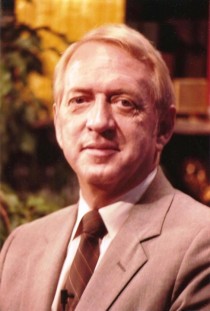
Many of the Weather Channel Pioneers came to The Weather Channel because of John. He was a TV weather rock star. He inspired and coached them in those hard early days as we all were feeling our way in a business for which there was no blueprint or precedent. He wondered whether he was too hard at times on his staff, which he loved dearly. But he felt it was his obligation to make sure they knew what we had to do differently being everyone’s local weather source.
John and many of the original pioneers chronicle how the Weather Channel evolved in this upcoming book. Those founding members of The Weather Channel had a reunion in 2012 in Atlanta and we were so pleased John celebrated with us there.
So many of our Pioneers responded to his sudden death with expressions of great sadness and recognition of him as a visionary who changed TV weather forever (first day responses).
His family honored his wishes to have no services but to issue a eulogy on his life. Here is an excerpt:
Pioneer, scientist, and meteorologist are all words that were John Coleman. Husband, father, grandfather, great grandfather, friend, mentor were the more important words that defined him.
Coleman’s first job in broadcasting was during his time as a high school student. He hosted a radio show on WCIL in Carbondale Illinois. In 1953, while he was a student at the University of Illinois he got his first TV job at WCIA in Champaign, Illinois doing the early evening weather forecast and hosting a local bandstand show called “At The Hop.” After receiving his degree in 1957, he became the weather anchor for WCIA’s sister station in Peoria, Illinois. Over his career, Coleman was meteorologist in Omaha and Milwaukee and then for 20 years he was the weather anchor for the ABC affiliate WLS-TV in Chicago.
During his time at WLS his pioneering in the broadcast world accelerated. He and his team at WLS developed a format that was coined “happy talk news” where the on-air personalities interacted with each other, a format used frequently today. In 1972, Coleman and his stage crew at WLS-TV created the first chroma key (green screen) weather map, a format used almost universally in TV weather forecasts today.
In 1975 Coleman became the original meteorologist when ABC launched its new morning show, Good Morning America. He stayed seven years with this top-rated program.
In the early 1980’s, John had a vision for 24-hour TV weather which he took from concept to reality in 1981 and which he named “The Weather Channel.” He served as its first CEO and President when The Weather Channel launched in 1982. It was during this time, he was honored by the AMS for “Outstanding Service by a Broadcast Meteorologist.”
After his time at The Weather Channel, Coleman returned to local TV in New York, Chicago, Palm Springs and then to KUSI in San Diego, where he was chief meteorologist for 20 happy years. John loved forecasting the “gorgeous” San Diego weather and it was the perfect end to an outstanding 61-year professional career.
During his time in San Diego and into his retirement, John was committed and passionate in his effort to educate the public about the false science behind claims of global warming. He spoke at conventions, narrated videos, wrote a popular blog, and never missed an opportunity to present the science debunking the climate change movement. His blog can be found at https://johncolemanblog.com/ . Coleman was also a policy advisor to The Heartland Institute, one of the world’s leading free-market think tanks promoting solutions to social and economic problems.
John was an energetic and passionate man about all he loved, including cards, especially poker. He loved life and was a lifelong learner. He will be remembered as a kind, funny, intelligent man who loved his profession, science and his family and friends. His mantra to his family members came from one of his favorite artist’s songs, Nat King Cole’s Nature Boy, “The greatest thing you’ll ever learn is just to love and be loved in return.”
------
John I wish we could tell you again how much we appreciate what you did for all of us who joined you on your impossible dream ride.
As Winston Churchill said “We make a living by what we get, but we make a life by what we give.” John, you gave so much to give your dream life.
From the Man of La Mancha song “Impossible Dream” these excerpted lyrics apply.
This is my quest
To follow that star
No matter how hopeless
No matter how farAnd I know if I’ll only be true
To this glorious quest
That my heart will lie peaceful and calm
When I’m laid to my restAnd the world will be better for this
That one man, scorned and covered with scars
Still strove with his last ounce of courage
To reach the unreachable star
Your heart should lie peaceful and calm. The world is a better place because you strove with your last ounce of courage to reach the unreachable star.
Frigid holiday season, snow bomb, now ?
I am sure you will agree we just had one of the coldest early winter holiday stretches in recent memory.
The two weeks starting Christmas had 12 days with lows below zero and no days exceeding the freezing mark.
Here is a plot from nearby Concord Airport of the daily highs and lows from Christmas day through Sunday, January 7th. The temperatures in this period averaged almost 18F below normal.
The cold was punctuated by the big nor’easter. The 12 to 17 inches of snow in our region with the January 4th storm was driven by powerful winds making the brutal cold feel even more intolerable.
This new thermal infrared image shows stunning detail of the powerful ‘bomb cyclone’ that struck the East Coast of North America on Jan. 2-3, 2018.
The powerful winter nor’easter delivered snow and ice, 50 to 80 mph wind gusts, and strong surf from northern Florida to Nova Scotia, Canada. Due to its rapid intensification (the barometric pressure at the center of the storm dropped 59 millibars in 24 hours), the storm ranks among the strongest ever observed along the East Coast.
The term ‘Bomb’ was coined by Professor Fred Sanders of MIT half a century ago. It refers to rapid intensification of winter storms in winter when both dynamic and thermodynamic factors combine to cause rapid storm development in a short period of time. I actually did my Master’s Thesis on Explosive Development in East Coast storms. They are most likely in very cold weather patterns like this one.
The cold and the snow brought some flashbacks to February 2015, which was the coldest month in the record books for Nashua and many other places in the northeast though this briefer stretch of very intense cold came with one significant snowstorm, 2015 had four in just over 5 weeks.
This year’s storm was likened to the Blizzard of 1978 though there were differences. Actually this storm was stronger storm with more wind, but snowfall amounts were less because the 1978 was a longer duration snow event. The tidal surge on the coast with this storm slightly exceeded the 1978 record levels but part of that was due to lunar factors. We had just before the storm experienced what was called Supermoon 2018 – when the moon was closest to the earth in its orbit (called Perigee), which made it visibly larger and 30% brighter. The resulting increased gravitational factors were already inducing higher tides.
A WIDESPREAD COLD
The cold was not confined to New England. The week from Christmas to New Year’s Eve was the second coldest December 25-31 on record for Chicago. In Chicago below 0F lows occurred on 10 of the 14 days starting after Christmas. Madison and Milwaukee Wisconsin had their second coldest December 25 to January 6th behind only 1886/87. See three areas had averages of 18F or greater below the normal. Only the southwestern states were warmer than normal this period. This pattern is very much like the one we predicted for the winter in the fall.
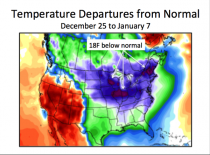
Enlarged
In cold winters, we often see the atmosphere take a break sometime from mid to late January before cold returns. That is called the January thaw.
It comes as Pacific air, which is blocked from entering the country during the cold period, invades from west to east, bringing mountain and northern tier snows but warmer temperatures and rains elsewhere. I remember in the winter of 1995/96, a winter with similarities to this one in the factors we use to forecast monthly and seasonal weather, we had a lot of early cold and snow and a blizzard on January 6-8th that deposited heavy snows from the Mid-Atlantic to southeastern New England.
It was followed by a January thaw and a heavy rainstorm that wiped out all the snow. The snow came back in February and March into April that left over 60 cities including Boston with all time seasonal snow records, broken here in the northeast in 2014/15.
The thaw has started this week and mild weather will continue on and off until late in the month or very early February when the cold pattern returns. Storms that occur during this interlude period will bring rain, wet snow of the threat of freezing rain. Our own model, which got the first part of winter right, has this for February and March.
For large version go to page 10 here and click to enlarge.
------------
French Alps hit by ‘once-in-a-generation’ snow storms
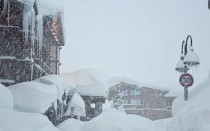
Parts of the French Alps have been hit by the kind of snowfall that only comes once every 30 years. These images show ski resorts buried in the snow.
Schools, nurseries have been closed and roads cut off in the French Alps after the Savoie department was placed on red alert—the highest warning—for avalanches on Monday.
Near the French-Italian border, in Haute Maurienne and Haute Tarentaise snow levels reached up to 80-90 centimetres in just 24 hours with the “maximum intensity” of the snowfall hitting on Monday evening.
“We will have had 2.40 m of snow in 48 hours,” said the mayor of Bonneval-sur-Arc Gabriel Blanc on BFMTV on Monday night.
The ski resorts of Tignes and Val d’Isere were in lockdown with the pistes closed until further notice.
The region remained on alert on Tuesday as it struggled to deal with the spell of snowfall that had an “unusually high intensity,” according to national weather agency Meteo France.
Preventative releases of avalanches will be set in motion as soon as the helicopters can take off, local authorities have said.
This shot was taken at the ski resort of Bonneval sur Arc.
